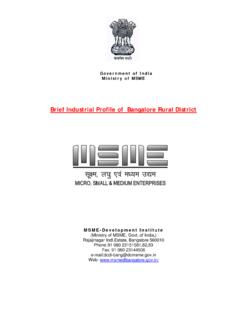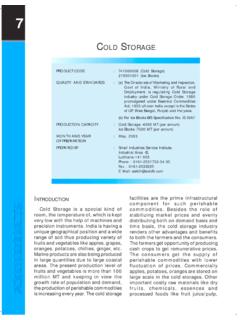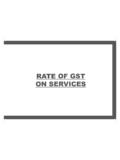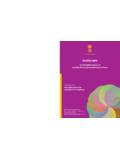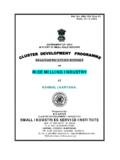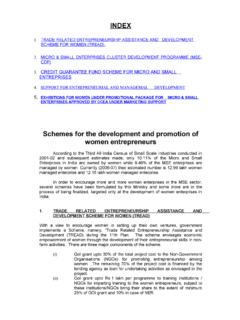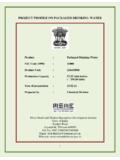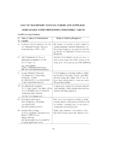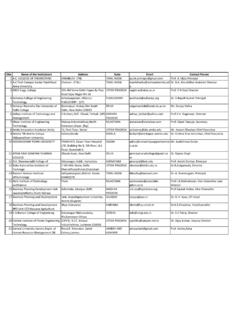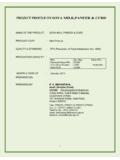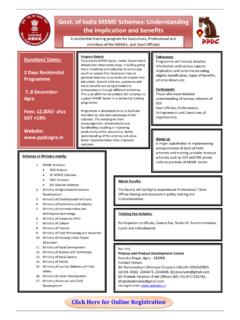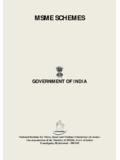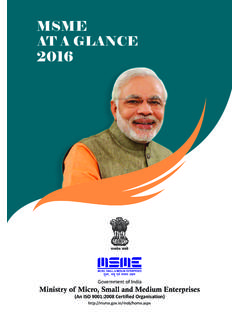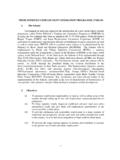Transcription of SELECT INDICATORS : INDIA (2008-09) - DCMSME
1 SELECT INDICATORS : INDIA (2008-09) Gross Domestic Product (GDP)$ trillion Per capita GDP$830 GDP by sectorAgriculture17%Industry29%Services5 4% GDP growth Inflation Labour million Labour force by occupationAgriculture60%Industry12%Servi ces28% Unemployment Exports$169 billion Main partnersUS, UAE, Singapore, China, UK Imports$288 billion Main partnersChina, Saudi Arabia, UAE, US Foreign debt$231 billion Forex reserves$252 billion12In INDIA , the enterprises have been classified broadly into two categories: (i)Manufacturing; and (ii)Those engaged in providing/rendering of services. Both categories of enterprises have been further classified into micro, small and medium enterprises based on their investment in plant and machinery (for manufacturing enterprises) or on equipments (in case of enterprises providing or rendering services).
2 The present ceiling on investment to be classified as micro, small or medium enterprises is as under:Investment Ceiling for Plant, Machinery or Equipments*@ClassificationManufacturing EnterprisesService EnterprisesMicroUpto lakh ($50 thousand)Upto lakh ($20 thousand)SmallAbove lakh ($50 thousand) &Above lakh ($20 thousand) & upto crore ($1 million)upto crore ($ million)MediumAbove crore ($1 million) & Above crore ($ million) & upto crore ($2 million)upto crore ($1 million)* Fixed costs are obviously before 2 October 2006 Investment Ceiling for Plant & Machinery or Fixed Assets*ClassificationManufacturing EnterprisesService EnterprisesMicroUpto lakh ($50 thousand)Upto lakh ($20 thousand)SmallAbove lakh ($50 thousand) & upto crore ($ million)
3 MediumNot definedNot defined* Excluding land and building.@ $1 = (April 2009).DEFINITION OF MSMEs IN INDIAthQuick Estimates of 4 Census (2006-07) Number of million Number of Manufacturing million Number of Service million Number of Women million (8%) Number of Rural million ( ) million Per unit Per unit fixed lakh Per unit original value of Plant & lakh Per unit gross lakh Employment per one lakh fixed , SMALL AND MEDIUM ENTERPRISES ( msme ) SECTOR: PROFILE4 The evolution of the policy framework and support measures of the Government can be broadly grouped into the following three periods:1948-1991: In all the Policy Resolutions from 1948 to 1991, recognition was given to the micro and small enterprises, termed as an effective tool to expand employment opportunities, help ensure equitable distribution of the national income and facilitate effective mobilization of private sector resources of capital and skills.
4 The Micro, Small and Medium Enterprises Development Organisation [earlier known as Small Industries Development Organization (SIDO)] was set up in 1954 as an apex body for sustained and organised growth of micro, small and medium enterprises. Within next two years, the National Small Industries Corporation, the Khadi and Village Industries Commission and the Coir Board were also set up. The era provided the supportive measures that were required to nurture MSEs, in the form of reservation of items for their exclusive manufacture, access to bank credit on priority through the Priority Sector Lending Programme of commercial banks, excise exemption, reservation under the Government Purchase Programme and 15% price preference in purchases, infrastructure development and establishment of institutes for entrepreneurial and skill development.
5 msme Development Institutes [earlier known as Small Industries Service Institute (SISI)] were set up all over INDIA to train youth in skills/entrepreneurship. Tool Rooms were established with German and Danish assistance for providing technical services essential to MSEs as also for skill-training. At the State level, District Industries Centres were set up all over the country. 1991-1999: The new Policy for Small, Tiny and Village Enterprises of August, 1991 laid the framework for government support in the context of liberalisation, which sought to replace protection with competitiveness to infuse more vitality and growth to MSEs in the face of foreign competition and open market. Supportive measures concentrated on improving infrastructure, technology and quality.
6 Testing Centres were set up for quality certification and new Tool Rooms as well as Sub-contracting Exchanges were established. The Small Industries Development Bank of INDIA (SIDBI) and a Technology Development and Modernisation Fund were created to accelerate finance and technical services to the sector. A Delayed Payment Act was enacted to facilitate prompt payment of dues to MSEs and an Industrial Infrastructure GOVERNMENT POLICIES AND SUPPORT MEASURES : BRIEF HISTORY5 Development (IID) scheme was launched to set mini industrial estates for small industries. 1999 onwards: The Ministry of msme [earlier known as Ministry of Small Scale Industries and Agro & Rural Industries (SSI & ARI)] came into being from 1999 to provide focused attention to the development and promotion of the sector.
7 The new Policy Package announced in August, 2000 sought to address the persisting problems relating to credit, infrastructure, technology and marketing more effectively. A Credit Linked Capital Subsidy Scheme was launched to encourage technology upgradation in the MSE sector and a Credit Guarantee Scheme was started to provide collateral-free loans to micro and small entrepreneurs, particularly the first generation entrepreneurs. The exemption limit for relief from payment of Central Excise duty was raised to crore ($ million) and a Market Development Assistance Scheme for MSEs was introduced. At the same time, consultations were held with stakeholders and the list of products reserved for production in the MSE sector was gradually reduced each year.
8 In 2006, the long-awaited enactment for this sector finally became a reality with the passage of the Micro, Small and Medium Enterprises Act. In March, 2007, a third Package for the Promotion of Micro and Small Enterprises was announced which comprises the proposals/schemes having direct impact on the promotion and development of the micro and small enterprises, particularly in view of the fast changing economic environment, wherein to be competitive is the key of , Small and Medium Enterprises Development Act, 2006 The Micro, Small and Medium Enterprises Development (MSMED) Act, 2006 seeks to facilitate the development of these enterprises as also enhance their competitiveness. It provides the first-ever legal framework for recognition of the concept of enterprise which comprises both manufacturing and service entities.
9 It defines medium enterprises for the first time and seeks to integrate the three tiers of these enterprises, namely, micro, small and medium. The Act also provides for a statutory consultative mechanism at the national level with balanced representation of all sections of stakeholders, particularly the three classes of enterprises; and with a wide range of advisory functions. Establishment of specific Funds for the promotion, development and enhancing competitiveness of these enterprises, notification of schemes/programmes for this purpose, progressive credit policies and practices, preference in Government procurement to products and services of the micro and small enterprises, more effective mechanisms for mitigating the problems of delayed payments to micro and small enterprises and assurance of a scheme for easing the closure of business by these enterprises are some of the other features of the Act.
10 Foreign Direct Investment (FDI) Policy With the promulgation of the MSMED Act, 2006, the restrictive 24% ceiling prescribed for equity holding by industrial undertakings, whether domestic or foreign, in the MSEs has been done away with and MSEs are defined solely on the basis of investment in plant and machinery (manufacturing enterprises) and equipment (service enterprises). Thus, the present policy on FDI in MSE permit FDI subject only to the sectoral equity caps, entry routes and other relevant sectoral regulations. Limited Liability Partnership (LLP) Act, 2008 The salient features of the proposed LLP Act, 2008 are as under:(i)LLP shall be a body corporate and a legal entity separate from its partners.
